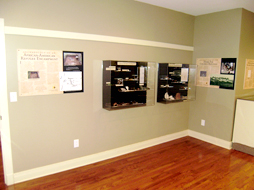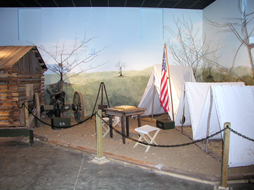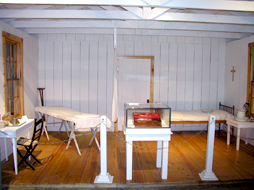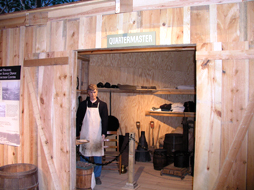|
Camp Nelson displays impress visitors,
tell story of facility’s historic significance
“Beautiful … Great Presentation … Excellent Job … Great source of History.”
Wayne Hayden hears such comments every month when visitors view living history displays at Camp Nelson, Jessamine County’s Civil War heritage park.
 The five museum displays, housed in the park’s Interpretive Center, each focus on a specific part of the Camp Nelson Supply Depot history. The life-size displays include replicas of a quartermaster facility, a hospital, camp life, refugee life (shanty and duplex), plus an archaeology room. Included are historical panels with documentation through photographs, quotes and drawings from historical documents. The five museum displays, housed in the park’s Interpretive Center, each focus on a specific part of the Camp Nelson Supply Depot history. The life-size displays include replicas of a quartermaster facility, a hospital, camp life, refugee life (shanty and duplex), plus an archaeology room. Included are historical panels with documentation through photographs, quotes and drawings from historical documents.
Constructed in 2007-08, a year of hard work was required to build the displays, paint murals and obtain documentation. Hayden, the park’s manager, coordinated the effort with assistance from Dr. Stephen McBride, camp director of Interpretation and Archaeology, and Jessamine County Magistrate George Dean.
Hayden, however, is quick to credit his wife, Betty, and volunteers and inmates from the Jessamine County Detention Center with participation in the actual construction.
The Quartermaster Depot display is 13-by-16 feet in size and contains samples of the many trappings and paraphernalia required to operate a Union camp for more than 10,000 African-American soldiers during the Civil War. The Hospital Ward is 18x12 feet, a Camp Life display is 250 square feet, and a Refugee Shanty is a 9x9 structure. A nearby duplex measures 13x17 feet. Life-size mannequins dressed in period clothing and uniforms also are featured in the displays.
Hayden, whose background is in construction, used his experience and his interest in the Civil War to move the display project forward. The displays are a key part of a museum designed to provide self-guided tours about the camp and its three-year history. Tour guides also are available, not only for the museum, but for other park information.
Museum items and the displays themselves required a lot of searching, persuading and funds to obtain authentic reproduction.
“Estate sales, loans and donations from interested citizens helped tremendously,” Hayden said. “We also constructed some items to the required specifications if they were not available, such as wagons, cannons and stretchers. We emphasized that everything should be as authentic as possible.
“The log shanty and duplex, for example, were constructed based on written records from the era. We also are in the process of building an ambulance for the museum.”
Many visitors are surprised that the Jessamine County Fiscal Court maintains the park and its facilities rather than a state or federal agency.
“Local residents are amazed that the museum and displays exist in such detail,” Hayden added. “Many are unaware of the actual activities that happened at Camp Nelson with reference to the supply depot, training, size, refugee story and impact the camp had on military activities.
“Foreign visitors also are favorably impressed with the displays, natural trails and presentation of the site.”
The park has more than five miles of walking trails and a barracks replica completed in 2009. Hayden also supervised its construction, the front section of which depicts living conditions for the soldiers stationed there. Simple bunks, a pot-bellied stove, tables and storage units are among the features. The rear portion of the structure houses a computer center with a planned library for research activities.
Established in 1863, Camp Nelson was named after Union Major Gen. William (Bull) Nelson, who founded Camp Dick Robinson, the first Union recruitment camp in Kentucky.
“It was the largest depot and permanent encampment in Kentucky outside of Louisville,” Dr. McBride, a historical archaelogist, notes. “It served a critical function to the Union war effort by providing supplies, livestock and troops for the Army of the Ohio in Kentucky, Tennessee and Alabama. In all, nearly 80,000 Union troops passed through this garrison.
“The greatest national significance of the camp, however, was that it was one of the largest recruitment camps for African-American troops. Eight regiments of U.S. Colored Troops – as the regiments were designated – were founded at Camp Nelson and three others were trained here. This number makes it the largest African-American recruitment camp in Kentucky and the third largest in the nation.”
Many of the black recruits – who were emancipated upon enlistment - brought their families with them to the camp in the hope they also would be freed or, at least, escape slavery.
|


















 The five museum displays, housed in the park’s Interpretive Center, each focus on a specific part of the Camp Nelson Supply Depot history. The life-size displays include replicas of a quartermaster facility, a hospital, camp life, refugee life (shanty and duplex), plus an archaeology room. Included are historical panels with documentation through photographs, quotes and drawings from historical documents.
The five museum displays, housed in the park’s Interpretive Center, each focus on a specific part of the Camp Nelson Supply Depot history. The life-size displays include replicas of a quartermaster facility, a hospital, camp life, refugee life (shanty and duplex), plus an archaeology room. Included are historical panels with documentation through photographs, quotes and drawings from historical documents.